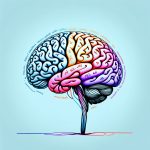Burnout, while not technically a mental disorder, will affect most people at some stage in their careers. It is often conceptualised as the negative trio of exhaustion, cynicism (or depersonalization), and a reduced sense of professional efficacy. However, a more recent study conceptualised it as a combination of two, rather than three distinct symptom-areas.
Table of Contents
Two Factors of Burnout
When we talk about “burnout”, we are talking about the insidious combination of two emotionally and physically challenging symptom-areas:
Exhaustion is the consequence of prolonged and intense exposure to physical, emotional, and cognitive strain resulting from specific working conditions or stressors. This involves not only feeling emotionally drained but also physical and cognitive symptoms of exhaustion, such as needing extended periods of rest. This broader conceptualization of exhaustion applies to a diverse range of workers, including those who are involved in physically demanding roles, and those who primarily engage in information-processing tasks.
Disengagement refers to a range of emotions related to the work task, such as finding it uninteresting, no longer challenging, or even “disgusting.” It also involves an often negative, cynical attitude, and a devaluation of one’s work and mechanical execution of tasks. Disengagement represents a comprehensive and intense reaction that includes emotional, cognitive, and behavioural rejection of the job, and involves a sense of occupational disillusionment.
Four Temporary Symptoms Leading to Permanent Burnout
It is theorised that burnout is actually preceded by four temporary symptoms. However, if they linger around for too long, they can lead to burnout:
- Mental Fatigue: Mental fatigue refers to a temporary decline in mental and physical efficiency due to the intensity, duration, and pattern of previous mental strain. Individuals experiencing mental fatigue may initially feel tired, notice less favourable effort-performance relationships, and later struggle with concentration and exhaustion. Recovery from mental fatigue typically requires time-consuming recuperation, such as rest breaks.
- Monotony: Monotony is a state of reduced mental activation that can occur during repetitive tasks with a narrow focus of attention, particularly in monotonous job conditions. It is associated with feelings of drowsiness, tiredness, decreased adaptability, and responsiveness. Unlike fatigue, monotony can be immediately alleviated by changing the work activity, making it a short-term strain reaction.
- Satiation: Satiation is a state characterized by a strong emotional aversion to repetitive tasks or situations where it feels like one is “marking time” or making no progress. Individuals in a state of satiation reluctantly perform tasks and experience physiological hyperactivity. Satiation disappears when the task changes but may spill over to similar tasks, potentially leading to a significant loss of motivation.
- Stress Sensations: Stress sensations are complex psycho-physiological reactions resulting from unacceptable, conflicting, or threatening demands. These sensations often arise from perceived over- or under-load, such as time pressure, leading to frustration with personal goals and aversive consequences. Stress sensations are characterized by uneasiness, tension, and anxious assessments of the work situation. Prolonged exposure to stress sensations can lead to chronic stress, exhaustion, shifts in aspiration levels, and ultimately, adverse effects on one’s health.
What the research says
Researchers found that burnout is categorically different from the short-term and reversible effects of the four preceding components, namely mental strain, including mental fatigue, monotony, satiation, and stress sensations. Importantly, the two components of burnout, Exhaustion, and Disengagement, are consistent across different human service professions and industrial production work settings, meaning that burnout might be universal across industries.
Burnout in human service professionals may manifest as exhaustion due to emotionally demanding interactions with patients or clients and a sense of depersonalisation in treating them. Recognising these signs early is crucial, which is why many professionals seek support from a first responder psychologist.
In contrast, burnout in manufacturing work includes similar basic elements but differs in its expression, as there are no recipients of services, leading to more generic symptoms of exhaustion and disengagement.
Is Stress the Same as Burnout? Is it Bad?
It seems like there is a positive association between mental fatigue and exhaustion, as well as between satiation and monotony and disengagement, across various work sectors.
However, stress sensations did not significantly contribute to exhaustion and were negatively related to disengagement in the production sub-sample.
This finding challenges the conventional assumption that short-term stress reactions serve as antecedents to burnout.
Assessing Burnout at Work
The relationships between the short-term effects of strain and burnout have practical implications for the early evaluation of a job’s burnout potential. This evaluation can be comparable to assessing the risk factors for fatigue, monotony, satiation, and stress sensations. By understanding these associations, it becomes possible to prevent burnout through job (re)design strategies rather than solely relying on individual-focused approaches.
This shift in perspective moves away from blaming individuals for burnout and emphasizes the importance of addressing inappropriate or impairing working conditions.
12 Steps to Prevent Burnout
Let’s look at 12 work-design goals that could help prevent burnout (as suggested by the ISO 10075-2 standard).
1. Task Clarity Matters (Ambiguity of Task Goal)
Imagine having a task with vague objectives. It’s like trying to solve a puzzle without all the pieces. When designing tasks, it’s crucial to set clear goals and establish priorities. For instance, safety should always come before production efficiency. If multiple operators are involved, make sure everyone knows their part.
2. Finding the Right Balance (Complexity of Task Requirements)
Tasks should be challenging but not overwhelming. Think of it as walking a tightrope. Too much complexity means too many decisions in too little time. If a task is too complex for the team, consider using decision support systems. But don’t make it too simple either, as that can lead to boredom.
3. Have a Strategy (Serving Strategies)
When you have multiple tasks demanding attention, having a strategy is crucial. It’s like deciding how to handle a line of customers at a store. There are simple strategies like ‘first-in-first-out’ and more complex hierarchical approaches. If you use conditional strategies, make sure the conditions are crystal clear.
4. The Right Information is Key (Adequacy of Information)
Imagine trying to cook without the right ingredients. Having missing or unnecessary information can overload the brain. So, provide the information necessary for the task and nothing more.
5. No Room for Guesswork (Ambiguity of Information)
Interpreting unclear information is like solving a riddle. It’s essential to present information in a straightforward way. For example, use clear indicators like ‘acceptable’ or ‘not acceptable’ when displaying system states.
6. Clear Signals (Signal Discriminability)
Think of signal discriminability as making sure important messages stand out in a crowd. You can achieve this by adjusting signal intensity, using different codes like shapes and colours, reducing background noise, and employing technical tools.
7. Balance Redundancy
Redundancy can be helpful for cross-checking, like having a spare key for your car. But too much redundancy can be distracting. Plan redundancy based on operational needs and allow operators to choose the level that suits the task.
8. Keep It Compatible
Imagine if turning the volume up on your TV made the screen go black. Compatibility matters. Make sure information, controls, and responses align with user expectations. This includes considering how controls and systems interact.
9. Accuracy Matters, But Don’t Overdo It
While accuracy is crucial, demanding superhuman precision can be counterproductive. Use tools that match the job’s requirements.
10. One Task at a Time (Mostly)
Handling one task at a time is usually more efficient. But when you need to compare things, it’s like having side-by-side options.
11. Sharing Tasks Carefully (Time Sharing)
Doing too many things at once can overwhelm anyone. So, it’s often better to tackle tasks one by one, unless you’re a pro at multitasking.
12. Minimizing Time Delays
When the system responds slowly, it’s like waiting for a delayed text reply. Reducing such delays is essential to ease the mental workload.
In essence, optimizing mental workload involves clear communication, balanced task complexity, and ensuring that operators have the right tools to get the job done efficiently.
Please note that this blog post by Personal Psychology is not intended to provide professional advice. If you or someone you know is experiencing mental health difficulties, it is important to seek help from a qualified healthcare professional.





